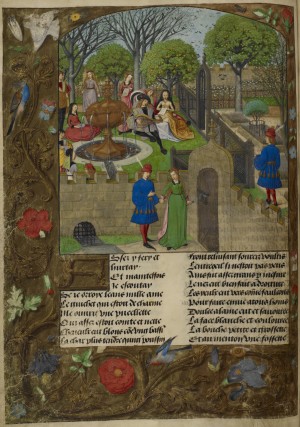The project
Professor Liz McAvoy (Department of English Language), is the Principal Investigator on this 24-month Leverhulme Trust funded research project – worth £156,548.
The Enclosed Garden: Pleasure, Contemplation and Cure in the Hortus Conclusus 1100-1450 focuses on the medieval hortus conclusus [enclosed garden] between 1100 and 1450, as it manifested itself within a number of contexts: literary, historical, theological, physical and medicinal. Specifically it aims to:
- examine the origins of the historical and literary framing of the enclosed garden and its functions in Jewish, Christian and Muslim contexts;
- trace the striking correlation between the myriad plants and spices populating the biblical Song of Songs, those described in treatises on the garden, and those in medical texts as cures for ailments of the womb and other specifically female disorders;
- challenge the notion of separate traditions for medieval understandings of the enclosed garden by scrutinizing the overlooked interstices and overlaps between these traditions;
- determine the extent to which the medieval garden was a gendered space and assess the role played by such a gendered understanding with medieval society and culture.

In the fourth chapter of the Song of Songs, one of the most popular and influential of biblical texts during the Middle Ages, the speaker famously professes, ‘My sister, my spouse, is a garden enclosed, a garden enclosed, a fountain sealed up (4:12). In this text, the hortus conclusus is depicted as a feminine space, the location of fertility, productivity, flourishing and unabashed sexuality and desire. Moreover, such insistent feminine poetics point towards the enclosed garden as ultimately synonymous with the female body – and the womb it houses: as the female speaker in the Song 5: 4 recounts: ‘My beloved put his hand through the key hole, and my bowels were moved at his touch.’
(Image: The Lover and Dame Idleness outside the Walled Garden (BL, MS Harley 4425, f.12v). By kind permission of the British Library)
As part of the Old Testament, the Song’s clear celebration of human desire and sexuality posed a very real problem to both Jewish and Christian theologians, who tended to re-read, re-configure, allegorise and re-allegorise it variously in terms of the relation between God and the Jews, or between Mary and Christ/Ecclesia and Christ/Christ and the human soul. Christian commentators, however, tended to read the entire poem as a celebration of the spousal relationship between the Virgin Mary and Christ. The most influential treatment of the Song in the Christian tradition was undertaken by Bernard of Clairvaux (d. 1153), who, in a series of allegorical commentaries, configured the Virgin as embodiment of the most intimate relationship between God and humanity, one that, moreover, reflected the type of spiritual union desired by the human soul. Bernard’s allegorical treatment, therefore, helped to establish an authoritative platform for the ubiquitous appearance of the enclosed garden as a sacred space that could operate as a multiple signifier in medieval writing and iconography.
Within the medieval imaginary, the enclosed garden also had close associations with the Garden of Eden and the Fall. It was from here that the Judeo-Christian problems of sexuality, pain and exile emanated because of the inconstancy of the first woman, Eve. More positive, allegorical readings of the Song therefore served to rehabilitate the garden and its occupiers within the Christian imagination, offering it as constructive, productive and sacred antidote to the far more dangerous Garden of Eden with its diabolic serpent at its centre. This newly reconstructed garden additionally provided a ‘safe’ space within which the ‘dangers’ of femininity could be enclosed, contained and reconfigured – so much so that, by the end of the Middle Ages, the Virgin Mary, as representative of the Immaculate Conception, was herself seen as the ‘garden’ of the divine Incarnation by means of her ‘enclosed’ and ‘sealed-up’ womb. The ultimate aim of this project, therefore, is to unpack the wider significances attached to the walled garden within medieval culture, along with the cultural work such multiple uses effected.

